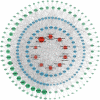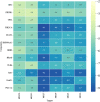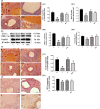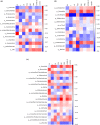Moringa oleifera leaf supplementation relieves oxidative stress and regulates intestinal flora to ameliorate polycystic ovary syndrome in letrozole-induced rats
- PMID: 37701184
- PMCID: PMC10494614
- DOI: 10.1002/fsn3.3473
Moringa oleifera leaf supplementation relieves oxidative stress and regulates intestinal flora to ameliorate polycystic ovary syndrome in letrozole-induced rats
Abstract
This study investigated the effects of supplementation Moringa oleifera leaf (MOL) on relieving oxidative stress, anti-inflammation, changed the relative abundance of multiple intestinal flora and blood biochemical indices during letrozole-induced polycystic ovary syndrome (PCOS). Previous studies have shown that MOL has anti-inflammatory, anti-oxidation, insulin-sensitizing effects. However, whether MOL has beneficial effects on PCOS remains to be elucidated. In the current study, 10-week-old female Sprague-Dawley rats received letrozole to induce PCOS-like rats, and subsequently were treated with a MOL diet. Then, the body weight and estrus cycles were measured regularly in this period. Finally, the ovarian morphology, blood biochemical indices, anti-oxidative, intestinal flora, and anti-inflammation were observed at the end of the experiment. We found that MOL supplementation markedly decreased the body weight, significantly upregulated the expression of Sirt1, FoxO1, PGC-1α, IGF1, and substantially modulated the sex hormone level and improved insulin resistance, which may be associated with the relieves oxidative stress. Moreover, the supplementation of MOL changed the relative abundance of multiple intestinal flora, the relative abundance of Fusobacterium, Prevotella were decreased, and Blautia and Parabacteroides were increased. These results indicate that MOL is potentially a supplementary medication for the management of PCOS.
Keywords: Moringa oleifera leaf; inflammation; intestinal flora; oxidative stress; polycystic ovary syndrome.
© 2023 The Authors. Food Science & Nutrition published by Wiley Periodicals LLC.
Conflict of interest statement
The authors declare no conflicts of interest concerning the authorship and/or publication of this paper.
Figures















Similar articles
-
Effect of High-Fat Diet on the Intestinal Flora in Letrozole-Induced Polycystic Ovary Syndrome Rats.Evid Based Complement Alternat Med. 2021 Jun 25;2021:6674965. doi: 10.1155/2021/6674965. eCollection 2021. Evid Based Complement Alternat Med. 2021. PMID: 34257691 Free PMC article.
-
Ameliorating effects of adropin on letrozole-induced polycystic ovary syndrome via regulating steroidogenesis and the microbiota inflammatory axis in rats.J Physiol. 2024 Aug;602(15):3621-3639. doi: 10.1113/JP285793. Epub 2024 Jul 9. J Physiol. 2024. PMID: 38980987
-
Naringenin regulates gut microbiota and SIRT1/ PGC-1ɑ signaling pathway in rats with letrozole-induced polycystic ovary syndrome.Biomed Pharmacother. 2022 Sep;153:113286. doi: 10.1016/j.biopha.2022.113286. Epub 2022 Jun 17. Biomed Pharmacother. 2022. PMID: 35724506
-
Dietary α-Linolenic Acid-Rich Flaxseed Oil Exerts Beneficial Effects on Polycystic Ovary Syndrome Through Sex Steroid Hormones-Microbiota-Inflammation Axis in Rats.Front Endocrinol (Lausanne). 2020 May 27;11:284. doi: 10.3389/fendo.2020.00284. eCollection 2020. Front Endocrinol (Lausanne). 2020. PMID: 32670195 Free PMC article.
-
Pathophysiological changes in experimental polycystic ovary syndrome in female albino rats: Using either hemin or L-arginine.J Cell Physiol. 2019 Jun;234(6):8426-8435. doi: 10.1002/jcp.27757. Epub 2018 Nov 15. J Cell Physiol. 2019. PMID: 30443939 Review.
Cited by
-
Melatonin protects chicken follicular granulosa cells against oxidative damage-induced apoptosis via inhibiting FOXO1 signaling pathway.Poult Sci. 2025 Jun 24;104(9):105472. doi: 10.1016/j.psj.2025.105472. Online ahead of print. Poult Sci. 2025. PMID: 40582162 Free PMC article.
-
Mangiferin ameliorates polycystic ovary syndrome in rats by modulating insulin resistance, gut microbiota, and ovarian cell apoptosis.Front Pharmacol. 2024 Sep 23;15:1457467. doi: 10.3389/fphar.2024.1457467. eCollection 2024. Front Pharmacol. 2024. PMID: 39376609 Free PMC article.
References
-
- Albrahim, T. , & Binobead, M. (2018). Moringa oleiferaRoles of leaf extract in improving the impact of high dietary intake of monosodium glutamate‐induced liver toxicity, oxidative stress, genotoxicity, DNA damage, and PCNA alterations in male rats. Oxidative Medicine and Cellular Longevity, 2018, 4501097. - PMC - PubMed
-
- Alqahtani, W. , & Albasher, G. (2021). Moringa oleifera Lam. Extract rescues lead‐induced oxidative stress, inflammation, and apoptosis in the rat cerebral cortex. Journal of Food Biochemistry, 45, e13579. - PubMed
-
- Aron‐Wisnewsky, J. , & Clément, K. (2016). The gut microbiome, diet, and links to cardiometabolic and chronic disorders. Nature Reviews. Nephrology, 12, 169–181. - PubMed
LinkOut - more resources
Full Text Sources
Research Materials
Miscellaneous

